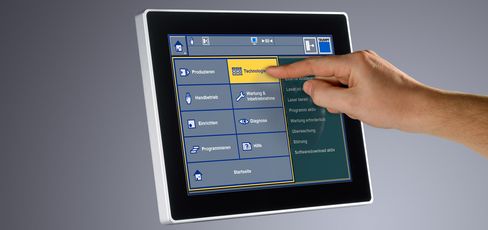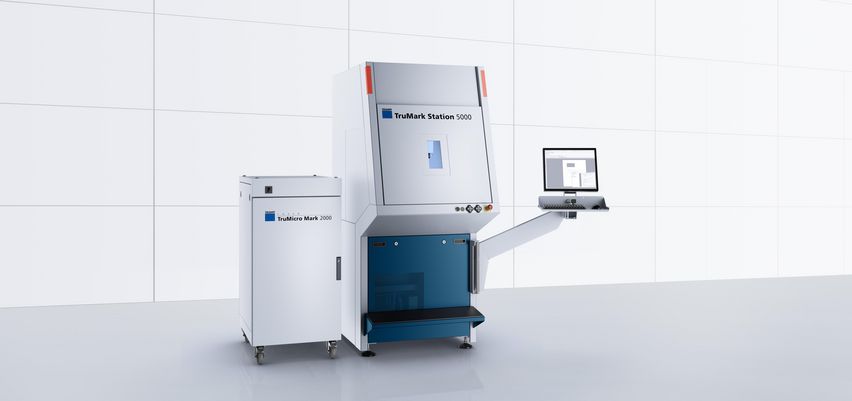The combination of the TruMark Station 5000 and the TruMicro Series 2000 provides an all-around, turnkey solution – the TruMicro Mark 2000. It is ideally suited for customers looking for a laser marking unit with picosecond and femtosecond pulses. With peak pulse powers of 0.5 MW, these lasers are used for processes where cold material processing is productive even with moderate average powers.
Compact, light, productive – the TruMicro Series 2000
Whether for structuring, ablating, cutting, or drilling: the laser has become an essential tool in micro-production technology. With its short and ultrashort TruMicro pulse lasers, TRUMPF offers innovative solid-state lasers that are tailored precisely to these tasks. They make it possible to perform micro-processing with an optimal combination of quality, productivity, and profitability. The fiber-based ultrashort pulse lasers in the TruMicro Series 2000 are distinguished by their compact and light design. Integrating the laser is made significantly easier by using a laser light cable for ultrashort pulse lasers (LLK-U). With their moderate average power they are ideally suited for foil cutting and the ablation of thin layers.
The laser light cable for ultrashort pulse lasers (LLK-U) facilitates machine integration without free-beam guidance.
Operate the TruMicro 2000 with different repetition rates, pulse energies, and pulse trains.
Advanced Pulse on Demand makes it possible to trigger laser pulses with trigger signals of varying frequency.
The TruMicro Series 2000 makes it possible to use cold processing for a large number of micro-processing applications.
Make use of the laser's strengths for corrosion-free black marking on metals.
The ultrafast power modulator keeps power and pulse energy at an exact level.

Interior glass marking
The TruMicro Series 2000 picosecond lasers can produce laser markings even on the inside of extremely thin glass. The ultrashort laser pulses place the marked points very close together. This results in entire color fields within thin glass that are just a few hundred micrometers thick. By selecting the correct process parameters you can even achieve a spectral color effect. The ultrashort laser pulses affect the diffraction of the glass. The energy input remains limited to a local area and the amorphous structure of the glass stays intact.

Black marking
A change in color, up to and including deep black, can be brought about in metals through laser processing, which is known as black marking. If the laser pulses used for this marking by annealing are ultrashort, the color change will remain corrosion-free.

Cold processing of polyimide foil
Polyimide is mainly used for producing flexible or rigid-flex printed circuit boards. The miniaturization of electronic devices necessitates a high level of flexibility and increasingly requires processing of the finest structures. The quality of the cutting edge is very important in this process, as the heat influence must not be detectable. The laser is optimally suited to meet these requirements and is almost always superior to traditional punching tools.

Micro-drilling in the circuit board substrate
You can use the laser to drill very small to larger holes in various materials without contact. With ultrashort lasers in the picosecond and femtosecond range, the material is vaporized from a solid state directly through sublimation and without melting the material, and as a result the component is not heated.

Laser-cut stent
The TruMicro Series 2000 is especially well-suited for producing medical technology products. You will be able to master the fine cutting tasks involved, for example, for cutting stents in medical technology through sublimation cutting. The lasers in the TruMicro Series 2000 produce high-quality cutting edges with no warping.
|
TruMicro 2020
|
TruMicro 2030
|
|
|---|---|---|
| Laser parameters | ||
| Average output power | 10 W | 20 W |
| Beam quality (M²) | < 1.3 | < 1.3 optional < 1.2 |
| Wavelength | 1030 nm | 1030 nm |
| Pulse duration |
20 ps
< 900 fs < 400 fs |
20 ps optional 900 fs
400 fs or variably adjustable from < 400 fs - 20 ps |
| Maximum pulse energy | 10 µJ Option: 20 µJ and 50 µJ | 20 µJ optional 50 µJ or 100 µJ |
| Maximum repetition rate | 1000 kHz Option: 2000 kHz, 200 kHz for 50 µJ pulse energy (10 W) | 1000 kHz optional 2000 kHz, 400 kHz at 50 µJ pulse energy (20 W) or adjustable from 200 kHz (100 µJ pulse energy) to 2 MHz (10 µJ pulse energy) |
| Structural design | ||
| Dimensions of laser head (W x H x D) | 570 mm x 360 mm x 180 mm | 570 mm x 360 mm x 180 mm |
| Dimensions of supply unit (W x H x D) | 510 mm x 485 mm x 180 mm | 510 mm x 485 mm x 180 mm |
The technical data of all product versions as a download.

TruControl
TruControl is the quick and easy-to-use control for TRUMPF solid-state lasers. It regulates the laser power in real time in order to deliver reproducible results. TruControl manages, controls, and visualizes the interface configuration. You benefit from a uniform control architecture across all laser technologies. The lasers have interfaces to control intelligent TRUMPF optics, such as monitored CFO focusing optics or PFO scanner optics. You can easily program the processing optics via the laser control system. The remote support service provided by TRUMPF means that you receive off-site support within seconds. This will allow you to avoid service calls or be as prepared as possible and increase the availability of the laser device.
With the useful options of the TruMicro Series 2000 lasers you can work more efficiently and with more process reliability.

Forego elaborate free-beam guidance and significantly simplify the machine design: instead of the free-beam guidance, the laser pulses are guided through the hollow core fibers from the laser source to the optics. The laser can be integrated in the processing machine much more flexibly thanks to this thermal and mechanical decoupling between the TRUMPF laser and the corresponding optics. The steel and pulse properties remain unaffected.

Interfaces are key for the integration of a TruMicro laser in your machine or production line. The solid-state lasers from TRUMPF offer interfaces to all common fieldbus systems. Also available: real-time interface, parallel digital I/O, interface for process sensor systems, OPC UA software interface, analog input board, interface for intelligent TRUMPF optics (CFO, PFO).

In the event of a fault, TRUMPF service experts will remotely access your laser via a secure remote connection. In many cases the fault can be remedied directly in this way, or the configuration of the laser can be modified in a way that permits you to continue manufacturing until the spare part arrives.
Multiple control loops in conjunction with a patented fast external modulator guarantee maximum process stability with the TruMicro Series 2000 as well as the set pulse parameters for each individual pulse.
If complex geometries are processed with scanners, for example when cutting polymer films, the acceleration and brake paths of the scanner lead to varying spatial intervals of the ultrashort laser pulses on the material. This means that the processing quality depends on the processing geometry. On the other hand, the repetition rate is adapted to the scan speed with the "Flexible Pulse on Demand" option, facilitating constant pulse intervals. This not only means that the process result is independent of the processing contour, but that the process time is decreased as well.
TRUMPF offers you all the components you need for beam guidance from the laser to the workpiece. This also applies for various focusing optics which have proven themselves to be precise and reliable over many years of industrial use. The optics can be easily integrated – both in stand-alone processing stations as well as in complete production lines. The modular structure enables the optics to be continually adapted to the laser types and various processing situations.
TOP Cleave cutting optics
The focusing optics TOP Cleave are processing optics for quickly cutting transparent materials such as glass or sapphire.
Ultrashort laser pulses are not only ultrashort; they also achieve peak values for pulse qualities such as energy and power. To ensure that the correct pulse is applied on the workpiece despite the peak intensity, special beam guidance and formation elements are required. TRUMPF offers beam switches, deflectors, beam expanders, and polarization optics that are optimized for use with ultrashort pulse lasers.

TruMicro deflectors are suitable for ultrashort laser pulses for guiding the laser beam while maintaining the pulse parameters.

With beam switches, the laser light from one beam source can be guided in two light paths for different workpieces. The pilot laser enables simple adjustment of the beam guidance and makes this as convenient as possible for you.

With a beam splitter two light paths can be powered at the same time, each with half the laser power. This allows you to work on two workpieces at the same time. The mechanical setting makes it possible to adjust the divided power precisely to the uniform distribution in both beam arms.

Circular polarized light is produced from linear polarized light with the help of a quarter wave plate and makes it possible to achieve consistent processing results for applications with directional production geometries.
This product range and information may vary depending on the country. Subject to changes to technology, equipment, price, and range of accessories. Please get in touch with your local contact person to find out whether the product is available in your country.
Find out more about high-quality, burr-free metal engraving.

Find your perfect pulsed laser now!
Use the product finder to discover which pulsed laser is best suited to your application!









